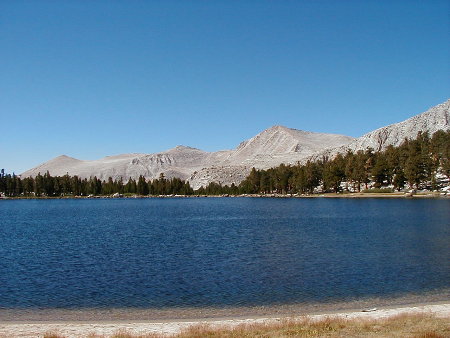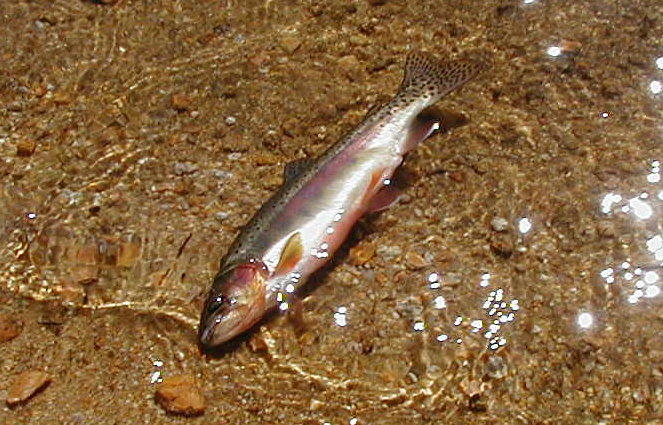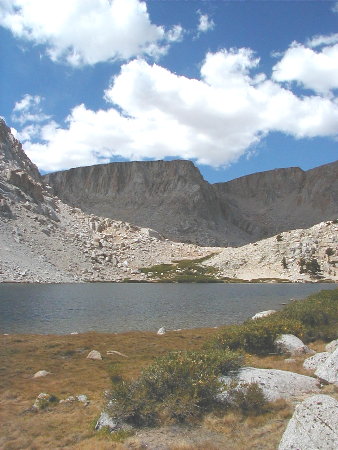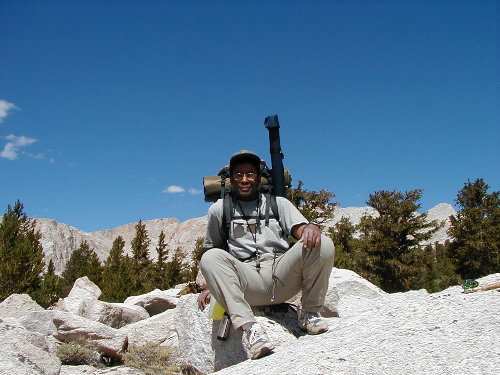|
|
|
|
|
Sept. 1- 3 2002 Cottonwood Lakes
Weather: Partly Cloudy to Cloudy Narrative: The Cottonwood Lakes basin is famous for itís Golden Trout fishing. At one point, the Cottonwood Lakes contained the stateís brood stock of Golden Trout. Fishing was prohibited as the Department of Fish and Game would harvest the fish in the lakes and distribute them via pack and air to remote lakes in the Sierra High Country. My understanding is that this is no longer the case.
Genetic testing has proven that the Goldens in the Cottonwood Lakes are not Goldens. Technically, theyíre hybrids. Those pesky Rainbows have once again spread their seed where it is not wanted. Somewhere in the past, perhaps the long distant past, a Rainbow Trout or 12 spread itís seed to the Cottonwood Lakes. Hence, from a scientific point of view they are Rainbow/Golden hybrids. From a fishing point of view, they are Golden Trout. After all, if the scientists couldnít tell the difference without a DNA test; we poor fisherman surely canít tell the difference. This trip was a series of firsts. My first trip to the Cottonwood Lakes, holy ground to High Sierra Golden Trout fishers. My first solo backpacking trip and my first time using two very distinct flies- the Black Magic and Denny Rickardís Stillwater Nymph. When one conceives of a solo backpacking trip, one thinks bears, peace, solitudeÖ.in that order. I found peace but very little solitude and no bears. The first night I camped at Muir Lake. Muir Lake was off the beaten path and looked to be a sure bet for a little solitude. A ranger I had spoken with described it as ďout of the wayĒ so I expected to have the lake to myself. This was not the case as I ran into a party of 15, a group that camps at the lake each Labor Day. Others would find their way to the lake as the day progressed and it seemed that every backpacker in the area was looking for the solitude an ďout of the way lakeĒ would provide. My guess is that by the end of the first evening there were close to 25 people camped at various spots along the lake. I camped on the far side of the lake, away from the crowds.
I had most of the fishing on the lake to myself. Most of the other people were at Muir Lake for the scenery or as a base from which to tackle Mt. Langley. Mt. Langley is above 14,000 feet and from what I was told, provides spectacular views of Mt. Whitney and the surrounding area. One fellow told me he cried when he reached the top. Another told me that there must have been 100 people trying to summit the mountain on that holiday weekend. He had to wait in line for 2hrs before he could summit. I didnít make the attempt but having so many people hike by me as I fished, made me acutely aware of the fact that I make little time for summit or site seeing excursions on my fishing trips. This is something that I will have to rectify. Itís a shame to travel all that way and not take full advantage of what nature has to offerÖbutÖI digress. I had most of the fishing on Muir Lake to myself. Starting from my campsite, I made my way around the lake in a counter clockwise fashion, casting to likely spots. I learned a lesson here. The first rule of stillwater fishing is to survey the lake, preferably from an elevated position from which you can ascertain the key structural elements of the lake. I had walked the lake to find a campsite but was too lazy to unpack my polarized sunglasses. Consequently, I missed the submerged weed bed and corresponding drop off on the north shore, water that I later found held active fish. With no fish actively feeding on the surface. I tied on a nymph and worked the like spots. I had two choices here- apply a strategy of working an area until I found the exact depth and retrieve that produced fish or fish one area and move on- varying my retrieve and depth from spot to spot. I chose the later and after two hours I found myself on the opposite side of the lake looking into a weed bed. I had retired my normal lake producers for something new. In truth, I have no regular high country lake flies that produce sub-surface. Iím simply not used to fishing deep for high country trout. Usually a Griffithís Gnat, Sierra Bright Dot, Black Ant or Grey Hackle Peacock does the trick. This year it seems all Iíve been doing is fishing deep- a non-descript nymph on Camp Lake, scuds in the Eldorado National Forest and Seal Buggers at Saddlebag Lake. I donít like fishing streamers or lures as the Brits call them. I like all my subsurface flies to be wet flies or nymphs. To that end, just before the trip, I tied up some wet flies I had seen in a British magazine and the Stillwater Nymph as presented in Denny Rickardís ďFly Fishing Stillwaters for Trophy TroutĒ. The Stillwater Nymph imitates a damsel but can double as a scud. I figured it would be a good fly to have on any lake but some high country lakes in particular are filled with scuds. The Black Magic was just something I liked but it turned out to be a pretty good black gnat imitation. On my first cast to the weed bed a fish slammed my Stillwater Nymph, Black Magic combination. I donít remember which fly was hit first or which was most productive. It really doesnít matter as I pulled in fish after fish on either nymph. My retrieve was a simple one. Cast out as far as I could, let the flies sink for 15 seconds (the Stillwater Nymph is tied with lead) and then commence a slow pull and pause and retrieve. Iíd pull the fly slowly about 6 inches and then pause for 4-8 seconds. The fish hit during the pause and within the first 10 feet of starting the retrieve. The fish were strong and in the 8 to 11 inch category. I hooked a larger fish, how much larger I can only guess. It made two jumps after breaking off on the hook set. It was a good fish though.
The next morning I fished the weed bed again. There had been little in the way of rising fish the night before or early that morning. I fished for about an hour before deciding to take a cross-country jaunt to Cottonwood Lake #3. Cottonwood Lake #3 is a long lake and there were fewer people there than I had expected. I quickly set up camp and strung up my rod. From my camp above the lake I could see that a drop off ran the length of the lake just below me. My plan, as always, was to look for cruising fish. When cruising fish arenít present then I fish the likely spots. Shallows, just above a drop off, are always a good place to find fish. Shallows and weed beds are the feeding lies of lakes. Fish will cruse the shallows for food and duck into the deeper water when predators (like me) are near. I walked to where the trail began to parallel the lake. Fishermen are largely lazy, on any given lake you can easily pick out the most heavily fished areas. These are the easiest to get to. This was one of those areas and I had no intention of starting my fishing there. This was until I happened to see 3 cruising trout. I expected the fish to be skittish so I made my first cast while on my knees, 10feet from the edge of the bank. I put one fish down immediately. He dashed for cover as my flyline flashed over the water. The second and third fish swam, unfazed out of range. One fish seemed to have a smaller cruising area and was quickly back into view. While casting to this fish I noticed a group of hikers making their way down the bank, toward me. They would surely spook the fish. Time was not on my side. With each cast they came closer. The fish ignored my seemingly on target casts. Just as the closest hiker was about to enter my chosen Goldenís window, I made a cast that the fish finally approved of. The hiker was more excited about the fish than I was. He quickly raced over to me. He could see I was working a fish and was afraid his approach would scare it off. His friends, two women from the Bay Area, soon joined us. He quickly explained that I had caught a Golden Trout and proceeded to take pictures of it. This would be the only chance I would have to have my picture taken with a fish during my solo trip. I handed the fellow my camera. He was so fixated on the fish that I had to remind him to include me in the picture!
Fishing on this day was slow. More people joined me on the bank and soon the fish took cover in the deeper water. A fellow and his girl friend began to fish not far from where I hooked the first trout. He was an experienced fly fisher, she was a beginner and I was given a glimpse of what I must be like when I am fishing with a beginner. He helped her cast and then began to explain how they were going fish. He began to narrate as he fished. He began to theorize aloud why they werenít catching fish. I had to chuckle to myself, Iíve done the same thing. We both sound as if we know whatís going on, we espouse our theories with such authority, when in truth we donít. It makes us feel better to think differently though! They werenít catching fish and at one point frustration seemed to seep in. His comments about her casting and their lack of success began to take a slightly annoyed tone. They fished dry flies I think, presumably over cruising fish. I remember him saying something to the effect that the fish were taking something very small and that he was tying on a size 20 something. A rain storm had threatened most of the afternoon and by 4pm, with several good hours of fishing left, lighting started to flash across the sky. Given the circumstances, standing on the bank of a high mountain lake waving a lighting rod wasnít an option. I retreated to my camp and spent the next several hours watching fish rise in the lake. It didnít rain one wit but the thunder and lighting was a constant companion. The next morning I broke camp and was on the water by 9 am. I planned to fish until 10 and then make my way to South Fork Lake. Over night I had decided to cut my trip short 1 day and return home to surprise my wife. If I left Cottonwood #3 at 10am, in theory I could be at South Fork Lake by 11am, fish until 3pm and be on the road by 7pm for the 7 hr drive back home.
Everything was going well. I fished until 10am and then made my way down the lakeside trail. The lake was quite long and at about 10:15 I happened to notice some rising fish. Innocently, I put on a Sierra Bright Dot and made a few casts. Then a pattern developed. Iíd walk a few paces and make a cast, walk a few more, make a few more casts. Again the fishing was consistent but this time on dries. The fish were spooky but the proper approach and cast would result in strike. Dry fly fishing has a certain seduction. I reached the far side of the lake at 1pm and worked my around to the other side. Again the fish were in the 8- 11 inch class. At 2pm I had to leave. It was too late to fish South Fork Lake but I could still make it to the car in time to head home. It was a short trek to Cottonwood Lakes #1 and #2. Unlike most high country lakes, these lakes are in a meadow, surrounded by tulle. Iím glad I hadnít planned to fish these lakes as they would best be fished with waders or with a float tube. If you ever plan to fish these lakes, my suggestion would be to do it at the end of the season when the marshy meadows dry up and thereís nary a mosquito in site. At Cottonwood Lake #1 I knew it was a short cross-country trek to South Fork Lake. There was no trail but on the map the route looked pretty straightforward. I had finally found the solitude I was looking for. Most of the people at Cottonwood Lake #3 had hiked out by noon and now as I crossed the main basin I was truly alone. I decided against the cross-country trek and headed down into the valley toward the trailhead. Iíd have one last chance to head to South Fork Lake. A quarter mile past Cottonwood Lake #1 was a trail that lead to South Fork Lake. Iíd have to trek back up hill but I knew that this would take me directly to the lake with little guesswork. I made the up hill journey and Iím glad I did. South Fork Lake was totally different than I expected. It also was situated in a meadow with some tulle growth but was the most beautiful lake of the 5 I had visited. I was short on time but made a few casts to fulfill my fishing ambitions for this trip. The view from South Fork Lake toward the valley I would have to cross is stunning. A trail follows South Fork creek back to the trailhead. This is the same creek that I had fished some years earlier. It quickly descends to the valley floor and is a long, fairly flat 3hr hike back to the car. The initial trail is very steep and not well defined. I would not recommend it for those not sure of foot nor those carrying heavy packs. Nor would I suggest taking this route to get to South Fork Lake, the Cottonwoods Lake trail is not nearly as steep, though is probably has more overall climbing. The hike back to the parking lot took less than my estimated 3hrs and I was back at the car, then back at home in no time. Vita was still up when I returned and I bored her with tails of mountains and trout.
Previous Golden Trout Wilderness chronicle Chronicle Index
|






